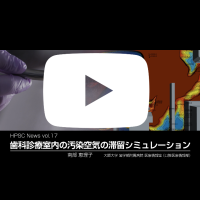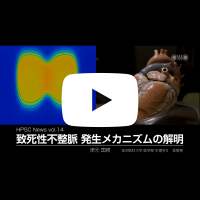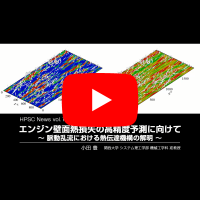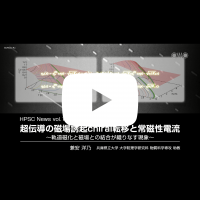HPCS News picks up researchers who conduct their advanced scientific research leveraging large-scale computer in the Cybermedia Center.

vol.19 AI-driven biomolecule design
Affiliation : School of Frontier Engineering, Kitasato University / Artificial Intelligence Research Center, The National Institute of Advanced Industrial Science and Technology
Proteins are utilized as functional molecules across a wide range of fields. Their applications are countless, including antibodies used as pharmaceuticals, enzymes that produce substances or break down contaminants, and fluorescent proteins that enable visualization within living organisms. In industry, there is a broad demand for designing such proteins and enhancing their functions. Traditionally, the development of functional proteins has required large-scale trial-and-error experimentation, but in recent years, attention has been shifting toward smart design using AI. In particular, a technology known as “protein language models,” which applies AI techniques behind language models like ChatGPT to the string representations of proteins, is rapidly advancing.

vol.18 PlantTwin: Reconstructing plants for breeding and cultivation
Affiliation : Graduate School of Information Science and Technology, The University of Osaka.
The ultimate goal of this research is the complete virtualization of plants from sensing data, i.e., the generation of a plant digital twin. This research focuses particularly on technical elements related to computer vision, and reproduces not only the shape of the plant from a set of images taken of the plant, but also its branch and leaf structure, time-series changes, etc., including occluded areas. The virtualized plant model enables simulation and mapping to genes, and is a powerful tool for automating cultivation and
accelerating breeding.

vol.17 Simulation of Contaminated Air Stagnation in a Dental Treatment Room
Affiliation : Osaka University Dental Hospital Division for Medical Informatics(Division for Oral Dental Informatics)
In dental practice, instruments such as turbines, which are used for cutting teeth, can cause droplets containing the patient’s saliva to scatter. Therefore, proper ventilation is necessary to ensure that the air containing these droplets does not remain stagnant for long periods. This study focuses on a private dental treatment room and visualizes the air stagnation using computational fluid dynamics (CFD) simulation and the air age evaluation metric. We compare scenarios of natural ventilation, where only doors and windows are open, with scenarios where air conditioning and HEPA filter-equipped air purifiers are used. Typically, running a single simulation requires a significant amount of time. However, by using the SQUID supercomputer, we were able to execute the simulations in a much shorter timeframe.

vol.16 Using AlphaFold2 to Discover Novel Protein-Protein Interaction Pairs - New Development in Functional Analysis
Affiliation : Germline Biology Group, Graduate School of Frontier Biosciences, Osaka University
There are about 10,000 to 20,000 different types of proteins in the cell, often forming complexes that are responsible for the physicochemical reactions of biological phenomena. Therefore, attempts to experimentally explore the binding of the protein under study to other proteins are widely performed. Recently, an AI program called AlphaFold2, developed by DeepMind, has attracted attention for its ability to predict protein monomer and complex structures from amino acid sequences. In this study, I attempted to use AlphaFold2 to rapidly screen protein complexes to aid in functional analysis. AlphaFold2 is operated on SQUID, and the computational flow was constructed to enable the prediction of about 150 pairs of complexes per day. In silico screening of proteins, assuming 1:1 binding, yielded a high reliability score for a number of pairs, corresponding to about 1% of the total. Today, AI programs are being actively developed and innovative technologies are having a profound impact on the life sciences, and the early adaptation and validation of such AI technologies, not only AlphaFold2, is expected to provide an opportunity to bridge the gap between experimental and computational science.

vol.15 Understanding the cleaning process in semiconductor manufacturing
Affiliation : Clean Technology Development Operations, SCREEN Semiconductor Solutions Co., Ltd.
In the semiconductor manufacturing process, single-wafer cleaning equipment that can treat rotating wafers with liquids containing various chemical substances is used to remove contaminant metals and nano-size particles from silicon wafers. In order to get high-performance and high-efficiency cleaning methods, it is important to know the liquid state such as the velocity and the thickness of the liquid film on the rotating wafer. However, the wafer rotates at high speed and the liquid film is extremely thin, making it extremely difficult to actually know the state of the chemically dangerous liquid. In this study, we attempted to clarify the liquid flow on a rotating wafer using CFD simulation using the LES-VOF method. Although the LES-VOF method can obtain detailed and highly accurate results, it takes too much time with normal computing power. By using the computing power of the supercomputer SQUID, we were able to clarify the detailed state of the liquid in a short period of time.

vol.14 An elucidation of the triggered activity formation mechanisms leading to lethal arrhythmias
Affiliation : Associate Professor, Faculty of Medicine, Kanazawa Medical University
The heart is the pump responsible for blood circulation, the work of life. Electricity (excitation) flowing accurately within the heart is required to function properly for the blood pump. An abnormality in the electrical flow (propagation of excitation waves caused by the excitation of myocardial cells) is an arrhythmia, and arrhythmias in the ventricles may be lethal. Although it has believed that excessive sustained excitation of myocardial cells causes abnormal electrical impulses, leading to the development of lethal arrhythmias, how ventricular arrhythmias are triggered by their electrical impulses is still not understood. In this study, we repeated simulations of excitation propagation on a myocardial sheet model consisting of human ventricular myocytes under various conditions using OCTOPUS in Cybermedia Center, Osaka University, and succeeded in elucidating the mechanism of the triggering phenomenon (triggered activity), resulting in the development of the lethal arrhythmia. These results will be useful for establishing methods to predict and prevent arrhythmia developments.

vol.13 First-principles calculations for single-molecule electronic transport
Affiliation : Assistant professor, Graduate School of Engineering Science, Osaka University
Single-molecule devices attract attentions to understand electron transport mechanisms in molecular scales, and find molecular design principles for promising organic devices. The exploring the relation between the bridging structure and electric conductance is important for this purpose. Since it is not possible to directly observe the bridging structure of the molecule between electrodes, we employed first-principles calculations to identify the molecular bridging structures. Electronic transport calculations are computationally expensive, since we need electrode atoms in addition to the molecule. Therefore, a large-scale computer like OCTOPUS, Cybermedia Center, is required. We have developed a method to unveil the junction structures by combining the unsupervised clustering and first-principles calculations and applied it for a molecule having complex anchors.

vol.12 Toward accurate prediction of cooling heat loss in reciprocating engines: Clarification of wall heat transfer mechanism in pulsating turbulent flows
Affiliation : Associate professor, Faculty of Engineering Science, Kansai University
In reciprocating internal combustion engines, such as automobile engines, 20 to 30% of the thermal energy generated by fuel combustion is lost as cooling heat loss. Cooling heat loss is the fraction of thermal energy transferred to the coolant through the wall, and must be minimized to improve engine thermal efficiency since it does not contribute to engine output. In this study, the complex flow and thermal fields in the engine cylinder caused by the reciprocating motion of the piston is modeled as “pulsating turbulent flow with strong repetitive acceleration/deceleration and wall heat transfer.” Highly accurate turbulence simulation method was applied to clarify the mechanism of wall heat transfer in the pulsating turbulent flow. We believe that, through such simulations, clarifying the limitations of heat transfer models widely used in current design processes will contribute to the development of advanced models that can predict heat loss with higher accuracy.

vol.11 Molecular simulation on water and ions in the self-assembled membranes - Prediction of molecular properties by using computer simulation -
Affiliation : Specially Appointed Lecturer, Graduate School of Information Science, University of Hyogo
Specially Appointed Lecturer, Graduate School of Information Science, University of Hyogo
Abstract: The water-treatment membrane is a key issue to keep the safe and secure environments for water supply toward the sustainable development goals. In order to understand the nature of molecular transport in the membrane, we’re challenging the computational observation of water and ion dynamics in the nanomaterial by using the supercomputer. In this study, the reason why water molecules move fast inside the nanoconfinement is clarified with the simulation methods of quantum chemistry and classical molecular dynamics.

vol.10 Field-induced chiral transition and paramagnetic current in superconductivity ~Chiral phenomena generated by paramagnetic coupling of orbital magnetization to magnetic field~
Affiliation : Assistant Professor, Department of Material Science, Graduate School of Engineering, University of Hyogo
Electrons are pairing in the superconducting state, and various superconducting phenomena occur as features of spin and orbital of electron pairs. One of the phenomena is the chiral state with intrinsic orbital magnetization which generates the spontaneous field. It is not clarified why the chiral superconducting state yields. We study the nature of chiral state by simulation based on the Ginzburg-Landau equation. The numerical analysis clarifies the field-induced chiral transition, paramagnetic supercurrent, and the inversion of chirality. These phenomena are caused by the paramagnetic coupling between the orbital magnetization and the external magnetic fields when the superconducting state varies depending on the distance. The vector parallelization is useful for analyzing the dependence of chiral superconducting state, and it is performed by the SX-Aurora TSUBASA at the Cybermedia Center.

